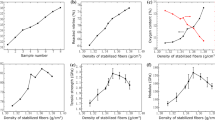Abstract
Highly oriented polyacrylonitrile (PAN) fibers, which are used in the preparation of high-performance carbon fibers, were prepared via a wet spinning process. The supramolecular structure—i.e., the degree of crystallinity, crystal size, and crystallite orientation—of the PAN fibers was characterized by X-ray diffraction (XRD) using fiber and powder techniques. Two equatorial diffraction peaks with 2θ ∼ 17° and 29.5° were observed in the fiber XRD patterns, which confirmed that the crystalline structure of the PAN fibers was pseudohexagonal with only two-dimensional order in the transverse direction. The powder XRD patterns were resolved into three constituent Lorentz peaks to determine the relative degree of crystallinity. In order to increase the reproducibility of the value for the crystallinity of the fibers, the Gupta–Singhal method was modified by assuming that the degree of crystallinity could be determined from the area under peak 1 (with 2θ ∼ 17°), rather than the combined area of peaks 1 and 3. The evolution of the supramolecular structure of the PAN fibers during the spinning process was also investigated. Results indicated that drying and steam stretching play important roles in the formation and growth of the crystalline structure of the PAN fibers, while the orientation of the structure was only strongly related to the degree of stretching. The effects of the supramolecular structure on the thermal properties and mechanical properties of the PAN fibers were also studied. The perfection of the supramolecular structure influenced the feasibility of cyclization reactions within the PAN fibers and the thermal decomposition of those fibers. The mechanical properties of the PAN fibers were significantly enhanced by increasing the perfection of the supramolecular structure.












Similar content being viewed by others
References
Huang X (2009) Fabrication and properties of carbon fibers. Materials 2:2369–2403
Liu Y, Kumar S (2012) Recent progress in fabrication, structure, and properties of carbon fibers. Polym Rev 52:234–258
Frank E, Steudle LM, Ingildeev D, Spӧrl JM, Buchmeiser MR (2014) Carbon fibers: precursor systems, processing, structure, and properties. Angew Chem Int Ed 53:5262–5298
Quan L, Zhang H, Xu L (2015) Orientation and thermal properties of carbon nanotube/polyacrylonitrile nascent composite fibers. J Polym Res. doi:10.1007/s10965-015-0769-4
Wang B, Zhao C, Xiao S, Zhang J, Xu L (2012) Effect of the aggregation structure on the thermal shrinkage of polyacrylonitrile fibers during the heat-treatment process. J Appl Polym Sci 125:3545–3551
Bohn CR, Schaefgen JR, Statton WO (1961) Laterally ordered polymers: polyacrylonitrile and poly(vinyl trifluroacetate). J Polym Sci 55:531–549
Hinrichsen G (1973) On the origin of order–disorder in drawn polyacrylonitrile. J Appl Polym Sci 17:3305–3321
Holland VF, Mitchell SB, Hunter WL (1962) Crystal structure and morphology of polyacrylonitrile in dilute solution. J Polym Sci 62:145–151
Klement JJ, Geil PH (1968) Growth and drawing of polyacrylonitrile crystals grown from solution. J Polym Sci Part A-2(6):1381–1399
Henrici-Olivé G, Olivé S (1979) Molecular interactions and macroscopic properties of polyacrylonitrile and model substance. Chem Adv Polym Sci 32:123–152
Warner SB, Uhlmann DR (1979) Oxidative stabilization of acrylic fibres. Part 3: Morphology of polyacrylonitrile. J Mater Sci 14:1893–1900
Bashir Z, Rastogi S (2005) The explanation of the increase in slope at the T g in the plot of d-spacing versus temperature in polyacrylonitrile. J Macromol Sci Part B 44:55–78
Bashir Z (2001) The hexagonal mesophase in atactic polyacrylonitrile: a new interpretation of the phase transitions in the polymer. J Macromol Sci Part B 40:41–67
Bai Y, Wang C, Lun N, Wang Y, Yu M, Zhu B (2006) HRTEM microstructures of PAN precursor fibers. Carbon 44:1773–1778
Yu M, Wang C, Bai Y, Zhu B, Ji M, Xu Y (2008) Microstructural evolution in polyacrylonitrile fibers during oxidative stabilization. J Polym Sci Part B Polym Phys 46:759–765
Ouyang Q, Chen Y, Zhang N, Mo G, Li D, Yan Q (2011) Effect of jet swell and jet stretch on the structure of wet-spun polyacrylonitrile fiber. J Macromol Sci Part B 50:2417–2427
Liu XD, Ruland W (1993) X-ray studies on the structure of polyacrylonitrile fibers. Macromolecules 26:3030–3036
Chae HG, Minus ML, Kumar S (2006) Oriented and exfoliated single wall carbon nanotubes in polyacrylonitrile. Polymer 47:3494–3504
Gupta AK, Singhal RP (1983) Effect of copolymerization and heat treatment on the structure and X-ray diffraction of polyacrylonitrile. J Polym Sci Part B Polym Phys 21:2243–2262
Hinrichsen G (1972) Structural changes of drawn polyacrylonitrile during annealing. J Polym Sci Part C 38:303–314
Bell JP, Dumbleton JH (1971) Changes in the structure of wet-spun acrylic fibers during processing. Text Res J 41:196–203
Murthy NS, Minor H (1990) General procedure for evaluating amorphous scattering and crystallinity from X-ray diffraction scans of semicrystalline polymers. Polymer 31:996–1002
Mikolajczyk T, Rabiej S, Bogun M (2006) Analysis of the structural parameters of polyacrylonitrile fibers containing nanohydroxyapatite. J Appl Polym Sci 101:760–765
Matta VK, Mathur RB, Bahl OP, Nagpal KC (1990) Crystallinity of PAN precursors. Carbon 28:241–243
Ouyang Q, Wang H, Cheng L, Sun Y (2007) Effect of boric acid on the stabilization of poly(acrylonitrile-co-itaconic acid). J Polym Res 14:497–503
Ju A, Guang S, Xu H (2014) A high performance carbon fiber precursor containing ultra-high molecular weight acrylonitrile copolymer: preparation and properties. J Polym Res 21:569. doi:10.1007/s10965-014-0569-2
Acknowledgements
The authors would like to thank Prof. Dr. Phillip H. Geil at the University of Illinois for his valuable suggestions, and they acknowledge the financial support provided by the National Natural Science Foundation of China (no. 21404111).
Author information
Authors and Affiliations
Corresponding author
Rights and permissions
About this article
Cite this article
Ouyang, Q., Chen, Y., Wang, X. et al. Supramolecular structure of highly oriented wet-spun polyacrylonitrile fibers used in the preparation of high-performance carbon fibers. J Polym Res 22, 229 (2015). https://doi.org/10.1007/s10965-015-0865-5
Received:
Accepted:
Published:
DOI: https://doi.org/10.1007/s10965-015-0865-5




